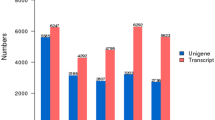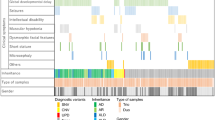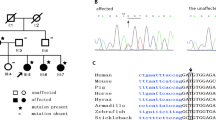Abstract
Purpose Ultraviolet irradiation is known to cause oxidative DNA damage and is thought to be a major factor implicated in the pathogenesis of pterygium. The highly mutagenic 8-hydroxy-2′-deoxyguanosine, a marker for the evaluation of photo-oxidative DNA damage, can be repaired by human 8-oxoguanine glycosylase I (hOGG1). A transition of C to G at nucleotide position 1245 in exon 7 of the hOGG1 gene is associated with the substitution of cysteine for serine at codon 326. In this study, we investigated the association of the hOGG1 Ser326Cys polymorphism with pterygium in a Chinese population.
Methods In all, 70 patients and 86 controls were enrolled in this study. The Ser326Cys polymorphism was determined by the polymerase chain reaction-restriction fragment-length polymorphism analysis. The association between this genetic polymorphism and risk of pterygium was examined by χ2-test and logistic regression.
Results The allelic frequencies for the Ser and Cys variants of hOGG1 gene were not significantly different between the two groups. However, when compared with Ser/Ser and Ser/Cys genotypes combined, we found that the homozygous Cys/Cys genotype was more prevalent in pterygium patients than controls (P=0.024) with the odds ratio being 2.2 (95% CI: 1.1–4.5). In the pterygium group, the mean age of patients with the Cys/Cys genotype was younger than those with the other two genotypes (P=0.025).
Conclusions Our findings suggest that the 1245C → G transition in exon 7 of the hOGG1 gene, which results in Ser326Cys substitution of the enzyme, might play a role in the susceptibility of humans to pterygium.
Similar content being viewed by others
Log in or create a free account to read this content
Gain free access to this article, as well as selected content from this journal and more on nature.com
or
References
Wong TY, Foster PJ, Johnson GJ, Seah SK, Tan DT . The prevalence and risk factors for pterygium in an adult Chinese population in Singapore: the Tanjong Pagar survey. Am J Ophthalmol 2001; 131: 176–183.
Chan CM, Liu YP, Tan DT . Ocular surface changes in pterygium. Cornea 2002; 21: 38–42.
Gallagher MJ, Giannoudis A, Herrington CS, Hiscott P . Human papillomavirus in pterygium. Br J Ophthalmol 2001; 85: 782–784.
Detorakis ET, Sourvinos G, Spandidos DA . Detection of herpes simplex virus and human papilloma virus in ophthalmic pterygium. Cornea 2001; 20: 164–167.
Detorakis ET, Sourvinos G, Tsamparlakis J, Spandidos DA . Evaluation of loss of heterozygosity and microsatellite instability in human pterygium: clinical correlations. Br J Ophthalmol 1998; 82: 1324–1328.
Tan DT, Lim AS, Goh HS, Smith DR . Abnormal expression of the p53 tumor suppressor gene in the conjunctiva of patients with pterygium. Am J Ophthalmol 1997; 123: 404–405.
Ueda Y, Kanazawa S, Kitaoka T, Dake Y, Ohira A, Ouertani AM et al. Immunohistochemical study of p53, p21 and PCNA in pterygium. Acta Histochem 2001; 103: 159–165.
Detorakis ET, Drakonaki EE, Spandidos DA . Molecular genetic alterations and viral presence in ophthalmic pterygium. Int J Mol Med 2000; 6: 35–41.
Threlfall TJ, English DR . Sun exposure and pterygium of the eye: a dose–response curve. Am J Ophthalmol 1999; 128: 280–287.
Tang FC, Chen SC, Lee HS, Lin WF, Chou MC, Lee MC . Relationship between pterygium/pinguecula and sunlight exposure among postmen in central Taiwan. Chin Med J 1999; 62: 496–502.
Saw SM, Banerjee K, Tan D . Risk factors for the development of pterygium in Singapore: a hospital-based case–control study. Acta Ophthalmol Scand 2000; 78: 216–220.
Gazzard G, Saw SM, Farook M, Koh D, Widjaja D, Chia SE et al. Pterygium in Indonesia: prevalence, severity and risk factors. Br J Ophthalmol 2002; 86: 1341–1346.
Luthra R, Nemesure BB, Wu SY, Xie SH, Leske MC . The Barbados Eye Studies Group. Frequency and risk factors for pterygium in the Barbados Eye Study. Arch Ophthalmol 2001; 119: 1827–1832.
Booth F . Heredity in one hundred patients admitted for excision of pterygia. Aust N Z J Ophthalmol 1985; 13: 59–61.
Nolan TM, DiGirolamo N, Sachdev NH, Hampartzoumian T, Coroneo MT, Wakefield D . The role of ultraviolet irradiation and heparin-binding epidermal growth factor-like growth factor in the pathogenesis of pterygium. Am J Pathol 2003; 162: 567–574.
Lu L, Wang R, Song X . Pterygium and lipid peroxidation. Chin J Ophthalmol 1996; 32: 227–229.
Kielbassa C, Roza L, Epe B . Wavelength dependence of oxidative DNA damage induced by UV and visible light. Carcinogenesis 1997; 18: 811–816.
Kasai H . Analysis of a form of oxidative DNA damage, 8-hydroxy-2′- deoxyguanosine, as a marker of cellular oxidative stress during carcinogenesis. Mutat Res 1997; 387: 147–163.
Cheng KC, Cahill DS, Kasai H, Nishimura S, Loeb LA . 8-Hydroxyguanine, an abundant form of oxidative DNA damage, causes GT and AC substitutions. J Biol Chem 1992; 267: 166–172.
Greim H, Csanady G, Filser JG, Kreuzer P, Schwarz L, Wolff T et al. Biomarkers as tool in human health risk assessment. Clin Chem 1995; 41: 1804–1808.
Bruner SD, Norman DP, Verdine GL . Structural basis for recognition and repair of the endogenous mutagen 8-oxoguanine in DNA. Nature 2000; 403: 859–866.
Ishida T, Takashima R, Fukayama M, Hamada C, Hippo Y, Fujii T et al. New DNA polymorphisms of human MMH/OGG1 gene: prevalence of one polymorphism among lung-adenocarcinoma patients in Japanese. Int J Cancer 1999; 80: 18–21.
Kohno T, Shinmura K, Tosaka M, Tani M, Kim SR, Sugimura H et al. Genetic polymorphisms and alternative splicing of the hOGG1 gene, that is involved in the repair of 8-hydroxyguanine in damaged DNA. Oncogene 1998; 16: 3219–3225.
Le Marchand L, Donlon T, Lum-Jones A, Seifried A, Wilkens LR . Association of the hOGG1 Ser326Cys polymorphism with lung cancer risk. Cancer Epidemiol Biomarkers Prevent 2002; 11: 409–412.
Xing DY, Tan W, Song N, Lin DX . Ser326Cys polymorphism in hOGG1 gene and risk of esophageal cancer in a Chinese population. Int J Cancer 2001; 95: 140–143.
Elahi A, Zheng Z, Park J, Eyring K, McCaffrey T, Lazarus P . The human OGG1 DNA repair enzyme and its association with orolaryngeal cancer risk. Carcinogenesis 2002; 23: 1229–1234.
Takezaki T, Gao CM, Wu JZ, Li ZY, Wang JD, Ding JH et al. hOGG1 Ser(326)Cys polymorphism and modification by environmental factors of stomach cancer risk in Chinese. Int J Cancer 2002; 99: 624–627.
Tarng DC, Tsai TJ, Chen WT, Liu TY, Wei YH . Effect of human OGG1 1245CG gene polymorphism on 8-hydroxy-2′-deoxyguanosine levels of leukocyte DNA among patients undergoing chronic hemodialysis. J Am Soc Nephrol 2001; 12: 2338–2347.
Zhai R, Liu G, Ge X, Yang C, Huang C Wu C et al. Genetic polymorphisms of MnSOD, GSTM1, GSTT1, and OGG1 in coal workers' pneumoconiosis. J Occup Environ Med 2002; 44: 372–377.
van der Kemp PA, Blais JC, Bazin M, Boiteux S, Santus R . Ultraviolet-B-induced inactivation of human OGG1, the repair enzyme for removal of 8-oxoguanine in DNA. Photochem Photobiol 2002; 76: 640–648.
Thomas D, Scott AD, Barbey R, Padula M, Boiteux S . Inactivation of OGG1 increases the incidence of G:CT:A transversions in Saccharomyces cerevisiae: evidence for endogenous oxidative damage in DNA in eukaryotic cells. Mol Gen Genet 1997; 254: 171–178.
Acknowledgements
Supported by a grant (NSC 91-2320-B010-069) from the National Science Council, Taiwan. None of the authors have any commercial interest in the materials mentioned herein.
Author information
Authors and Affiliations
Corresponding author
Rights and permissions
About this article
Cite this article
Kau, HC., Tsai, CC., Hsu, WM. et al. Genetic polymorphism of hOGG1 and risk of pterygium in Chinese. Eye 18, 635–639 (2004). https://doi.org/10.1038/sj.eye.6700738
Received:
Accepted:
Published:
Issue date:
DOI: https://doi.org/10.1038/sj.eye.6700738
Keywords
This article is cited by
-
Unravelling the molecular tapestry of pterygium: insights into genes for diagnostic and therapeutic innovations
Eye (2024)
-
DNA damage and repair in endometrial cancer in correlation with the hOGG1 and RAD51 genes polymorphism
Molecular Biology Reports (2011)
-
Increased oxidative DNA damage, 8-hydroxydeoxy- guanosine, in human pterygium
Eye (2006)



